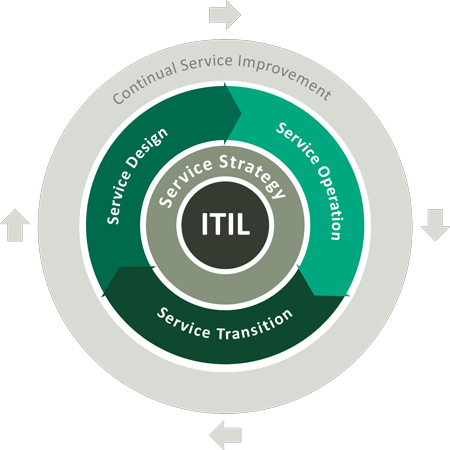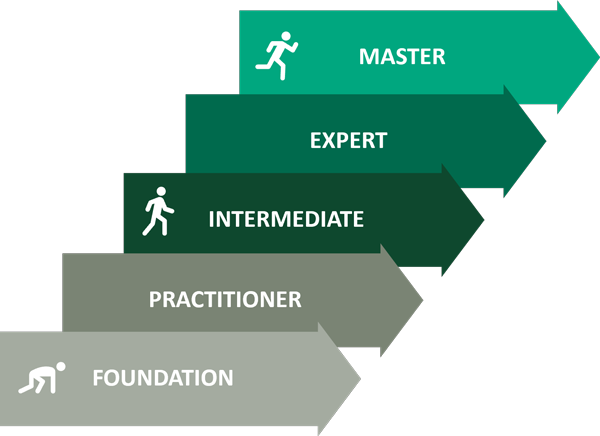ITIL (Information Technology Infrastructure Library) is a framework for IT service management that helps companies to organize their IT services more efficiently and effectively.
It defines processes, procedures and functions for IT Service Management (ITSM) and provides a comprehensive collection of best practices to help organizations plan, monitor and review their IT services.
ITIL is focused on satisfying the needs of customers and employees by ensuring continuous improvement of IT services. It is important to know that the ITIL framework is not a matter of mandatory standards, but of so-called best practices. In other words, it is about suggestions that have proven themselves in practice and can therefore also help your company.
History and Origin of ITIL
The UK government developed ITIL in the early 1980s to provide a standardized framework for IT service management. The first version of ITIL was published in 1989 and has been continuously developed since then to meet the changing needs of companies in the IT sector.
- Between 1989 and 1998, a total of 34 different documents were created, which were later referred to as Version 1.
- From 1999 to 2004 followed version 2, which has a structure according to the tasks in ITSM.
- In 2005, ISO 20000 was created as an ITIL-oriented certification model for organizations, which was last updated in 2018.
- ITIL v3 was published in June 2007 and its structure is based on the service lifecycle.
- In July 2011, an update of ITIL v3 was published under the title “ITIL 2011 Edition”.
- Since 2014, ITIL has been a trademark of AXELOS, a joint venture between CAPITA and Cabinet Office.
- From February 2019 to September 2020, ITIL 4 was created, which is currently the most up-to-date version.
- Following the successful implementation of ITIL 4, AXELOS has taken the decision to discontinue the previous version of the world’s leading certification in IT Service Management, ITIL v3, by the end of 2021.
ITIL was originally only used by government agencies and public institutions, but over time it has become more widespread and is now used worldwide by companies and IT organizations in various industries and sizes.
Benefits and Aims of ITIL
ITIL has established itself as a valuable tool for IT service management and is now a recognized best practice framework in the IT industry. Here we list the advantages it offers companies and the specific objectives it pursues:
In the short term, however, costs are incurred if you want to take advantage of the benefits of ITIL. In addition, there must be precise and conscientious preparation for ITIL in order to lay the perfect foundation.
That’s why you should always use ITSM tools that are ITIL-compliant. If you are unsure about this, you should get external support that has the relevant experience with the framework and its establishment – like REALTECH with SmartITSM. Because we support the ITSM processes with suitable tools that allow the processes to be implemented in an ITIL-compliant manner.
What is the Difference between ITIL and ITSM?
The terms ITSM and the Information Technology Infrastructure Library (ITIL for short) are often used interchangeably, although they are not the same thing. ITIL is a framework that supports IT Service Management (ITSM). Basically, other frameworks are also available for this purpose, but they are not as widely established.
The main focus of ITIL is to improve the efficiency and predictability of processes, incidents and request management. Basically, it is a guide that supports companies with the introduction of ITSM, among other things.
In short, ITIL is a generally recognized set of best practices designed to help organizations get the most out of IT by aligning their IT services with business strategy. Methods such as checklists, tasks and processes that any company can easily implement are used for this purpose.
In summary, ITIL processes can be part of ITSM, but not every ITSM in comparison uses or follows all standards defined in ITIL.
Overview of the most important ITIL Processes
How many ITIL processes are there?
The ITIL (Information Technology Infrastructure Library) has a total of 26 processes. These processes are divided into five phases of the ITIL service lifecycle:
- Service Strategy: This phase deals with strategic planning and the definition of business objectives.
- Service Design: This is where the services are developed and planned to ensure that they meet the business requirements.
- Service Transition: The focus is on the implementation and continuous improvement of services.
- Service Operation: This phase is all about the ongoing operation and management of the services.
- Continual Service Improvement: The aim of this phase is to continuously improve the efficiency and effectiveness of services.
Each of these phases comprises specialized processes aimed at seamlessly integrating and optimizing the entire service management lifecycle.
ITIL defines a set of processes necessary for effective and efficient IT service management. These processes cover the entire life cycle of an IT service, from planning and monitoring through to review and optimization.
Each ITIL process therefore has a specific objective and helps to ensure that IT services meet the needs of customers and business units. We will discuss the most important ITIL processes in the following:
ITIL Certificate: Overview, Requirements and Benefits
The ITIL certification is an internationally recognized qualification level for IT professionals and consultants who specialize in IT service management. It makes it possible to master the common language of IT professionals worldwide and improve their position within the IT community, as ITIL is the de facto standard in IT service management.
Overview of ITIL Certifications
The ITIL certification scheme provides a modular approach to the ITIL framework and consists of a series of qualifications. These focus on different aspects of ITIL Best Practice in varying depth with practical relevance. There are a total of 11 levels of ITIL certification:
- ITIL 4 (as of 2019)
- ITIL 4 Foundation
- ITIL 4 Managing Professional
- ITIL 4 Specialist Create, Deliver and Support
- ITIL 4 Specialist Drive Stakeholder Value
- ITIL 4 Specialist High-velocity IT
- ITIL 4 Strategist Direct, Plan and Improve
- ITIL 4 Strategic Leader
- ITIL 4 Strategist Direct, Plan and Improve
- ITIL 4 Leader Digital and IT Strategy
- ITIL Master
Furthermore, these certificates are only valid for 3 years, are no longer valid indefinitely as with ITIL3 and must therefore be recertified.
Requirements for ITIL Certification
To earn ITIL certification, the following requirements must be met:
It is important to note that the requirements for ITIL certifications may be adjusted from time to time. It is therefore advisable to find out about the current requirements directly from an authorized training provider or examination center.
Benefits of ITIL Certification
ITIL is the best-known framework for ITSM. By completing an ITIL certification, you will learn all the relevant terminology. IT professionals in all industries and regions use and understand them. You can then prove your ITIL knowledge with the respective ITIL certificate. Specifically, ITIL certification offers you the following advantages:
Application of ITIL in practice
The best framework is only as good as its implementation. Only if you pick up your employees in the best possible way will they successfully apply ITIL in practice. To give you a better idea of a successful implementation, we will look at the typical challenges involved in implementing ITIL.
Challenges in the Implementation of ITIL
ITIL is a framework and not a template that can simply be applied to any company. So if you want to implement the framework in your organization, here’s what you should consider:
Criticism and Application Problems
One of the biggest challenges when introducing new IT measures is convincing your employees to use them. This is because people are usually critical of new things and changes and prefer tried and tested methods and approaches. As a result, many projects are never or only insufficiently applied, even though they offer great technological advantages.
If this is not to happen, you must make it clear why the change is necessary and needed, e.g. to secure existing jobs and to be able to operate competitively in the future. The three most common hurdles in applying the ITIL framework and its associated processes are as follows:
Digitization plays a major role in all companies today, and IT provides most of the services. IT teams are at the heart of the digital transformation. Cloud computing, blockchain, AI and IoT: they are all driving new ways of working and are being implemented by Agile, Lean and DevOps experts.
In order to keep up in this world, IT organizations are looking for ways to increase the agility of companies and at the same time ensure greater stability and predictability. And this is exactly where ITIL can help, as the framework, when implemented correctly, promotes the user-friendliness of the IT infrastructure, collaboration and knowledge sharing within the company.
The latest update to the IT Infrastructure Library, ITIL 4, developed by the community for the community, was created based on the diverse views and best practices of over 2000 IT professionals across all roles, industries and communities worldwide, including Agile and DevOps.
The streamlined and practical guide, which can be adapted to new technology and integrates existing work methods with basic ITSM practices, helps to understand the following:
- How the service economy works in today’s world.
- How to always keep an eye on all processes with the help of the basic ITIL principles.
- How to integrate Lean, Agile and DevOps techniques into ITSM.
- How to create simple and practical value streams to respond to customer demand while creating value for all relevant stakeholders.
- How to develop practices to achieve optimal results with low risk.
ITIL 4 is certainly a paradigm shift for IT teams in terms of business and customer value. It supports a more adaptable approach based on your team’s needs and way of working. In short, the fundamental principles of ITIL 4 promote collaboration, efficiency and continuous feedback, which makes processes even more efficient for the future.
Conclusion on ITIL and recommendations for ITIL users
In summary, it can be said that ITIL is an intelligent framework that pays off if implemented correctly, because ITIL as a theoretical superstructure can serve as a very good guideline for the introduction of comprehensive IT solutions. The introduction of the processes described in ITIL is best done using a concrete IT solution such as ITSM. With SmartITSM , REALTECH offers a complete solution that enables companies to live, support, and automate ITIL processes.



